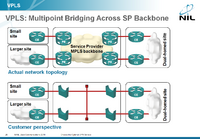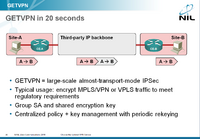Choose the Optimal VPN Service
Overall rating: 4.71 Instructor: 4.84 Materials: 4.76 more …
Are you confused by the breadth of services offered by competing Service Providers? Can you decide whether to use layer-3 MPLS VPN services or layer-2 VPN services? What’s the difference between pseudowires and VPLS? Or is it better to use Internet and build your own VPN?
This webinar will help you answer all these questions by giving you:
- A clear conceptual picture of how each VPN service works from the customer perspective;
- Benefits and drawbacks of using various VPN service types;
- High-level deployment recommendations for each VPN service type;
- Overview of high-availability designs.
The following VPN services are covered in the presentation:
- Layer-3 MPLS VPN services (formerly known as MPLS VPN)
- Layer-2 VPN services (pseudowires, VPWS, VPLS)
- IPSec-based VPN services over the Internet
- GETVPN
- DMVPN
- SSL-based VPN services
Contents
Introduction to VPN services
This section describes the major differences between point-to-point and multipoint VPN services as well as between provider-built and customer-build VPN services. It also introduces VPN services selection criteria, including lock-in considerations, end-to-end QoS options and CapEx (equipment) and OpEx (operations, maintenance and services) costs during the VPN service lifetime.
MPLS-based VPN services
When the Service Providers advertise next-generation services, they’re usually selling you MPLS-based VPN services. There are significant differences between layer-3 MPLS VPN services and layer-2 pseudowire and VPLS services. This section describes these differences, the benefits and drawbacks of different MPLS-based services and their long-term implications from the customer perspective.
IPSec- and GRE-based services
You can always build your own VPN service on top of third-party IP infrastructure, be it the Internet or MPLS/VPN or VPLS service. This section describes various GRE-based in IPSec-based VPN services, including highly scalable DMVPN and GETVPN solutions.
Hybrid solutions
If you don’t trust your Service Provider’s ability to run the core network, you can always build your own VPN service on top of their MPLS VPN offering. Likewise, you can build your own MPLS VPN service on top of IP infrastructure (including the Internet). This section briefly describes several potential hybrid scenarios.
Exclusions
The webinar does not address device configurations or other low-level technical details. We can cover these details in a follow-up discussion during the on-site delivery or you could attend in-depth technology-specific webinars as they become available.
Target audience
- IT managers and enterprise networking engineers who have to select the best VPN service (or mix of VPN services) for their enterprise WAN network.
- Consultants who have to recommend VPN service solutions to their clients.
- Service Provider teams who need to identify the expectations of their customer and match those expectations with their service offerings.
Happy Campers
About the webinar
- Top notch webinar as I mentionned on twitter !
- MCL Nicolas
- Definitelly worth spending time on attending this webinar. It clarifies things and lets make more reasonable choices
- Marcin Lebiecki
- Great information. This webinar is a presentation of 3 major categories of Virtual Private Networks. Its gives an overview of the benefits and drawbacks of the different options available. The considerations become very important as you navigate the decision-making process.
- Bonnie Thomas




 Ivan Pepelnjak (CCIE#1354 Emeritus) has been analyzing OpenFlow technology and SDN ideas (and being pretty vocal about their shortcomings) since March 2011, resulting in a number of high-impact events, on-site SDN workshops for large enterprises and service providers, and vendor-sponsored webinars.
Ivan Pepelnjak (CCIE#1354 Emeritus) has been analyzing OpenFlow technology and SDN ideas (and being pretty vocal about their shortcomings) since March 2011, resulting in a number of high-impact events, on-site SDN workshops for large enterprises and service providers, and vendor-sponsored webinars.